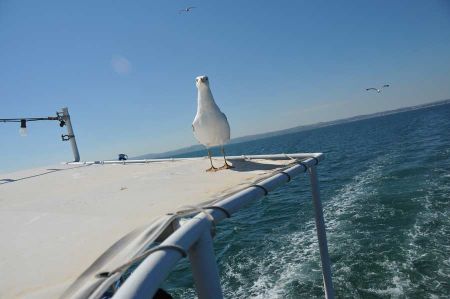Mediterranean gulls following ferry - observation at Perea
- Written by Portal Editor
Everyone knows about their biological association, as well might remember about a special experience with the huge birds to report about which others will not describe as unusual.
So they say seagulls, among other things, show no fear, sometimes even seem to want to be close to the people. Something like that also happened during the ferry crossing from Perea to Thessalonica.
During the sea-going process of the ferry in Perea, some Mediterranean gulls had appeared, which then followed the ferry above the slipstream almost sailing while researching for fish that occurred with partly high and long jumps in the wake of the ship. The Mediterranean gulls is about 52-58 cm big and shows a wingspan of 120-140 cm, little smaller than the very similar Herring gulls from Northern Europe. The body is built more compact and shows a stronger, more obtuse forward, something more rounded beak. The head appears larger, forward curved and flat on the crown. The abdomen is more slender, the wingtips will submit 5-7 cm above the tail at the sitting bird. The legs are relatively long, the bird thus acts legged.
So we watched some of the masterful fliers, in their dispute over the spoils. Here some of the birds came flying so close to the ferry or sailed nearby, that we could touch by hand. For sure, we could seen a lot of details so well that the yellow beak in some specimens showed so extensive Goneys points that it reached to the upper beak part. Some individuals in addition show something black next to Gonys point at the upper beak. The iris of birds is a kind of lemon yellow, the eye often surrounded by a red ring. The legs are striking yellow. The upper wing surface is up to a narrow white front and broad white trailing edge and a predominantly black section at the top of the hand wing also light gray.
While some birds kept large distance from the ferry, were else others, one had the impression that they would observe the movements on board, were ready even to the first landing approach on the ferry. With some noise first gulls landed on the sunroof, where they gave almost jubilant tones of itself; fast, deep and guttural cries consisting of many individual elements, this reminded corresponding cries of other northern gulls. Other gulls followed, so that some magnificent shadow due to the high-sun arose, we could hold photographically. We could even touch the feet of some birds without them flying away.
The Mediterranean gulls is basically a non-migratory bird, which can be found outside the breeding season in large parts of Europe. Roving end birds then probably try to find cheap food courts and at the same time to escape from the competition with other large gulls. After investigations of northwestern Spanish populations, one fifth of the young birds clips far around, the rest remain in the vicinity of the breeding places or drag inland. Adult birds search for the breeding season on cheap moulting areas such as the Ebro Delta and over winter near the breeding places later.
The Mediterranean gulls primarily breeds on rocky shores or on the coast of stored rocky and sandy islands, but also on mud islands or in the high growth of lagoons and salt pans, but also dunes are accepted. Regional brooding Mediterranean gulls on roofs within coastal villages, cities and port areas, so f. e. in Istanbul.
Outside the breeding season the Mediterranean gulls is mainly found in coastal areas, where they searching on the open sea or in fishing ports or beaches for food. Farther inland, principally along the rivers, they can also be found on agricultural land, to water and other landforms. Of particular importance also unfortunately are landfills.
The food spectrum is about as diverse as the herring gull. Since the range of the Mediterranean gulls due to dry falling silt and shore areas are rare at low tide, gulls occur molluscs and crustaceans back as a food ingredient, fish and squid take a greater share. In addition, land animals or snails to small mammals or cultivated crops such as grain, olives, figs are of greater importance.
The observed gulls at our ferry were always brave, so a bird ended up at all on the deck of our ferry, so we could do some close-ups. Not being afraid we could come closer. So the ferry trip designed far more interesting than previously thought.
Please read as well:
Silk Moth - ovipositioning on a Merlot wine bottle
Young swallows in the nest - shouting we are hungry
-
-
-
-
-
-
-
-
-
-
-
-
-
-
-
-
-
-
https://www.alaturka.info/en/life/fauna/3369-mediterranean-gulls-observation-during-ferry-trip-from-perea/amp#sigProId8058bbc424
